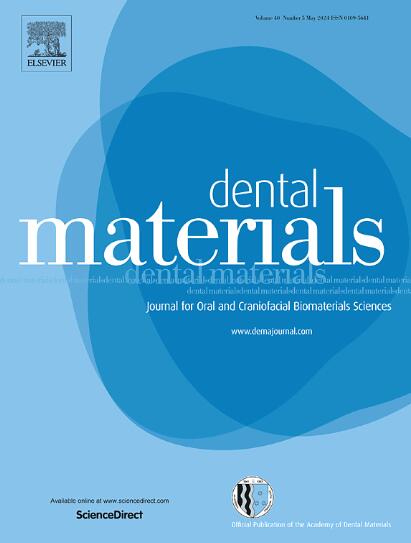Fatigue lifetime of reduced-diameter implants placed in different bone models
IF 4.6
1区 医学
Q1 DENTISTRY, ORAL SURGERY & MEDICINE
引用次数: 0
Abstract
Objectives
This study assessed the fatigue lifetime of reduced-diameter implants placed in either bovine rib or polymer-based bone model.
Methods
Bovine ribs were classified according to the criteria proposed by Lekholm and Zarb and were analyzed for bone fraction. Fourteen dental implants (3.25 mm in diameter × 15 mm in length) were placed in bovine ribs used as a bone model. They were subjected to resonance frequency analysis. Stainless steel loading hemisphere caps were bonded on the abutments position at 30-degree angle and with a moment arm of 11 mm. Accelerated life testing using the step-stress method was conducted at 2 Hz with a stress ratio of 0.1 until fracture on a servo-hydraulic load frames machine (MTS). Results were compared with those of a previous study wherein implants were placed in a polymer-based bone model. Fatigue lifetime statistics (characteristic lifetime and Weibull modulus) of physical specimens were estimated in a reliability analysis software (ALTA PRO). Fractured specimens were examined under an electron scanning microscope to determine the failure mode.
Result
The implants exhibited high stability quotient values (75.07 ± 3.81). Implants placed in bovine ribs showed better data dispersion and longer fatigue lifetime than those placed in polymer-based bone models, with no significant difference between groups. All fractures occurred in the implant body near the bone level and were indicative of fatigue fractures.
Significance
Bovine ribs appear to be a more suitable material for accelerated life testing than the polymer-based material because of better data dispersion.
在不同骨模型中植入小直径种植体的疲劳寿命。
研究目的本研究评估了在牛肋骨或聚合物骨模型中植入小直径种植体的疲劳寿命:方法:根据 Lekholm 和 Zarb 提出的标准对牛肋骨进行分类,并对骨量进行分析。将 14 个牙科植入体(直径 3.25 毫米 × 长度 15 毫米)植入作为骨模型的牛肋骨中。对它们进行共振频率分析。不锈钢加载半球帽以 30 度角粘接在基台上,力矩臂为 11 毫米。在伺服液压载荷框架机(MTS)上使用阶跃应力法以 2 Hz 的频率进行加速寿命测试,应力比为 0.1,直至断裂。测试结果与之前将植入物植入聚合物骨模型的研究结果进行了比较。在可靠性分析软件(ALTA PRO)中估算了物理试样的疲劳寿命统计数据(特征寿命和威布尔模量)。在电子扫描显微镜下对断裂试样进行检查,以确定失效模式:结果:植入物显示出较高的稳定性商值(75.07 ± 3.81)。与植入聚合物骨模型的种植体相比,植入牛肋骨的种植体显示出更好的数据分散性和更长的疲劳寿命,组间无显著差异。所有骨折都发生在靠近骨水平的植入体上,并显示为疲劳骨折:牛肋骨似乎比聚合物材料更适合用于加速寿命测试,因为其数据分散性更好。
本文章由计算机程序翻译,如有差异,请以英文原文为准。
求助全文
约1分钟内获得全文
求助全文
来源期刊

Dental Materials
工程技术-材料科学:生物材料
CiteScore
9.80
自引率
10.00%
发文量
290
审稿时长
67 days
期刊介绍:
Dental Materials publishes original research, review articles, and short communications.
Academy of Dental Materials members click here to register for free access to Dental Materials online.
The principal aim of Dental Materials is to promote rapid communication of scientific information between academia, industry, and the dental practitioner. Original Manuscripts on clinical and laboratory research of basic and applied character which focus on the properties or performance of dental materials or the reaction of host tissues to materials are given priority publication. Other acceptable topics include application technology in clinical dentistry and dental laboratory technology.
Comprehensive reviews and editorial commentaries on pertinent subjects will be considered.
 求助内容:
求助内容: 应助结果提醒方式:
应助结果提醒方式:


